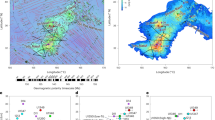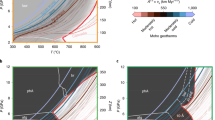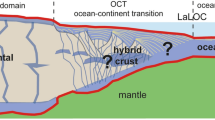Abstract
Ocean ridges, where Earth’s tectonic plates are pulled apart, range from more than 5-km depth in the Arctic to 750 m above sea level in Iceland. This huge relief is generally attributed to mantle plumes underlying mantle hotspots—areas of voluminous volcanism marked by ocean islands. The plumes are thought to feed the mantle beneath adjacent ocean ridges. This process results in thickened crust and ridge elevation to form ocean rises. The composition of mid-ocean ridge basalt, a direct function of mantle composition and temperature, varies systematically along ocean rises, but in a unique way for each different rise. Here we use thermodynamic calculations of melt-evolution pathways to show that variations in both mantle temperature and source composition are required to explain the chemical make-up of rise basalts. Thus, lateral gradients in mantle temperature cannot be uniquely determined from basalt chemistry, and ocean rises can be supported by chemically buoyant mantle or by robust mantle plumes. Our calculations also indicate that melt is conserved and focused by percolative flow towards the overlying ridge, progressively interacting with the mantle to shallow depth. We conclude that most mantle melting occurs by an overlooked mechanism, focused melting, whereas fractional melting is a secondary process that is important largely at shallow depth.
This is a preview of subscription content, access via your institution
Access options
Subscribe to this journal
Receive 12 print issues and online access
$259.00 per year
only $21.58 per issue
Buy this article
- Purchase on Springer Link
- Instant access to full article PDF
Prices may be subject to local taxes which are calculated during checkout





Similar content being viewed by others
References
Melson, W. G., Vallier, T. L., Wright, T. L., Byerly, G. & Nelen, J. Chemical diversity of abyssal volcanic glass erupted along Pacific, Atlantic, and Indian Ocean sea-floor spreading centers. Geophys. Pac. Ocean Basin Margin 19, 351–368 (1976).
Bryan, W. B. & Dick, H. J. B. Contrasted abyssal basalt liquidus trends: Evidence for mantle major element heterogeneity. Earth Planet. Sci. Lett. 58, 15–26 (1982).
Schilling, J-G. et al. Petrologic and geochemical variations along the Mid-Atlantic Ridge from 29° N to 73° N. Am. J. Sci. 283, 510–586 (1983).
Dick, H. J. B., Fisher, R. L. & Bryan, W. B. Mineralogic variability of the uppermost mantle along mid-ocean ridges. Earth Planet. Sci. Lett. 69, 88–106 (1984).
Klein, E. M. & Langmuir, C. H. Global correlations of ocean ridge basalt chemistry with axial depth and crustal thickness. J. Geophys. Res. 92, 8089–8115 (1987).
Gale, A., Langmuir, C. H. & Dalton, C. A. The global systematics of ocean ridge basalts and their origin. J. Petrol. 55, 1051–1082 (2014).
Cannat, M. et al. Ultramafic and gabbroic exposures at the Mid-Atlantic Ridge: Geologic mapping in the 15° N region. Tectonophysics 279, 193–213 (1997).
Small, C. & Danyushevsky, L. V. Plate kinematic explanation for mid-oceanic ridge depth discontinuities. Geology 31, 399–402 (2003).
Niu, Y. & O’Hara, M. J. Global correlations of ocean ridge basalt chemistry with axial depth: A new perspective. J. Petrol. 49, 633–664 (2008).
Presnall, D. C. & Gudfinnsson, G. H. Origin of the oceanic lithosphere. J. Petrol. 49, 615–632 (2008).
Wilson, J. T. A possible origin of the Hawaiian Islands. Can. J. Phys. 41, 863–870 (1963).
Zhou, H-y. & Dick, H. J. B. Thin crust as evidence for depleted mantle supporting the Marion Rise. Nature 494, 195–200 (2013).
Ito, G. & Behn, M. D. Magmatic and tectonic extension at mid-ocean ridges: 2. Origin of axial morphology. Geochem. Geophys. Geosyst. 9, Q09O12 (2008).
Weir, R. W. et al. Crustal structure of the northern Reykjanes Ridge and Reykjanes Peninsula, southwest Iceland. J. Geophys. Res. 106, 6347–6368 (2001).
Schilling, J-G. Iceland mantle plume: Geochemical evidence along Reykjanes Ridge. Nature 242, 565–571 (1973).
White, W. M., Schilling, J-G. & Hart, S. R. Evidence for the Azores mantle plume from strontium isotope geochemistry of the Central North Atlantic. Nature 263, 659–663 (1976).
Hart, R., Dymond, J., Hogan, L. & Schilling, J-G. Mantle plume noble gas component in glassy basalts from Reykjanes Ridge. Nature 305, 403–407 (1983).
Salters, V. J. M. & Stracke, A. Composition of the depleted mantle. Geochem. Geophys. Geosyst. 5, Q05B07 (2004).
Zindler, A. & Hart, S. Chemical geodynamics. Annu. Rev. Earth Planet. Sci. 14, 493–571 (1986).
Klein, E. M. & Langmuir, C. H. Local versus global variations in ocean ridge basalt composition: A reply. J. Geophys. Res. 96, 4241–4252 (1989).
Kinzler, R. J. & Grove, T. Primary magmas of mid-ocean ridge basalts 2. Applications. J. Geophys. Res. 97, 6907–6926 (1992).
Niu, Y. & Batiza, R. Chemical variation trends at fast and slow-spreading mid-ocean ridges. J. Geophys. Res. 98, 7887–7903 (1993).
Kushiro, I. The system forsterite-diopside-silica with and without water at high pressures. Am. J. Sci. 267-A, 269–294 (1969).
Presnall, D. C. & Hoover, J. D. Composition and depth of origin of primary mid-ocean ridge basalts. Contrib. Mineral. Petrol. 87, 170–178 (1984).
Dick, H. J. B. The Origin and Emplacement of the Josephine Peridotite 400 PhD thesis, Yale Univ. (1976)
Dick, H. J. B. & Natland, J. H. in Scientific Results Vol. 147 (eds Gillis, K., Mevel, C. & Allan, J.) 103–134 (Texas A&M University, 1996).
Dick, H. J. B. & Natland, J. R. An Offset Drilled Mantle Section: Evidence for Focused Melt Flow Beneath the East Pacific Rise from ODP Leg 147 Abstract vol. 25, 444 (Geological Society of America, 1993).
Kelemen, P. B., Shimizu, N. & Salters, V. J. M. Extraction of mid-ocean-ridge basalt from the upwelling mantle by focused flow of melt in dunite channels. Nature 375, 747–753 (1995).
Asimow, P. D. A model that reconciles major- and trace-element data from abyssal peridotites. Earth Planet. Sci. Lett. 169, 303–319 (1999).
Ghiorso, M. S. & Sack, R. O. Chemical mass-transfer in magmatic processes. 4. A revised and internally consistent thermodynamic model for the interpolation and extrapolation of liquid–solid equilibria in magmatic systems at elevated-temperatures and pressures. Contrib. Mineral. Petrol. 119, 197–212 (1995).
Johnson, K. T. M., Dick, H. J. B. & Shimizu, N. Melting in the oceanic upper mantle: An ion microprobe study of diopsides in abyssal peridotites. J. Geophys. Res. 95, 2661–2678 (1990).
Dick, H. J. B. in Magmatism in the Ocean Basins, Geological Society Special Publication No. 42 (eds Saunders, A. D. & Norry, M. J.) 71–105 (Geological Society of London, 1989).
Dick, H. J. B., Tivey, M. A. & Tucholke, B. E. Plutonic foundation of a slow-spreading ridge segment: Oceanic core complex at Kane Megamullion, 23° 30′ N, 45° 20′ W. Geochem. Geophys. Geosyst. 9, Q05014 (2008).
Sauter, D. et al. Focused magmatism versus amagmatic spreading along the ultra-slow spreading Southwest Indian Ridge: Evidence from TOBI side scan sonar imagery. Geochem. Geophys. Geosyst. 5, Q10K09 (2004).
Spiegelman, M. Geochemical consequences of melt transport in 2-D: The sensitivity of trace elements to mantle. Earth Planet. Sci. Lett. 139, 115–132 (1996).
Asimow, P. D. & Stolper, E. M. Steady-state mantle-melt interactions in one dimension: I. Equilibrium transport and melt focusing. J. Petrol. 40, 475–494 (1999).
Ghiorso, M. S., Hirschmann, M. M., Reiners, P. W. & Kress, V. C. III The pMELTS: A revision of MELTS for improved calculation of phase relations and major element partitioning related to partial melting of the mantle to 3 GPa. Geochem. Geophys. Geosyst. 3, 1–36 (2002).
Wasylenki, L. E., Baker, M. B., Kent, A. J. R. & Stolper, E. M. Near-solidus melting of the shallow upper mantle: Partial melting experiments on depleted peridotite. J. Petrol. 44, 1163–1191 (2003).
Baker, M. B. & Stolper, E. M. Determining the composition of high-pressure mantle melts using diamond aggregates. Geochim. Cosmochim. Acta 58, 2811–2827 (1994).
McKenzie, D. & Bickle, M. J. The volume and composition of melt generated by extension of the lithosphere. J. Petrol. 29, 625–679 (1988).
Asimow, P. D. & Langmuir, C. H. The importance of water to oceanic melting regimes. Nature 421, 815–820 (2003).
Niu, Y. & Batiza, R. Chemical variation trends at fast and slow spreading mid-ocean ridges. J. Geophys. Res. 98, 7887–7902 (1993).
Kelemen, P. B., Hirth, G., Shimizu, N., Speigelman, M. & Dick, H. A review of melt migration processes in the adiabatically upwelling mantle beneath oceanic spreading ridges. Phil. Trans. R. Soc. Lond. A 355, 283–318 (1997).
Dantas, C. et al. Pyroxenites from the Southwest Indian Ridge, 9–16° E; cumulates from incremental melt fractions produced at the top of a cold melting regime. J. Petrol. 48, 647–660 (2007).
Dick, H. J. B., Lissenberg, C. J. & Warren, J. Mantle melting, melt transport and delivery beneath a slow-spreading ridge: The Paleo-MAR from 23° 15′ N to 23° 45′ N. J. Petrol. 51, 425–467 (2010).
Warren, J. M. & Shimizu, N. Cryptic variations in abyssal peridotite compositions: Evidence for shallow-level melt infiltration in the oceanic lithosphere. J. Petrol. 51, 395–423 (2010).
Asimow, P. D., Dixon, J. E. & Langmuir, C. H. A hydrous melting and fractionation model for mid-ocean ridge basalts: Application to the Mid-Atlantic Ridge near the Azores. Geochem. Geophys. Geosyst. 5, Q01E16 (2004).
Standish, J. J. The Influence of Ridge Geometry at the Ultraslow-Spreading Southwest Indian Ridge (9°–25° E): Basalt Composition Sensitivity to Variations in Source and Process PhD thesis, Woods Hole Oceanographic Institution and the Massachusetts Institute of Technology (2006)
Langmuir, C. H., Klein, E. M. & Plank, T. in Mantle Flow and Melt Generation at Mid-Ocean Ridges Vol. 71 (eds Phipps Morgan, J., Blackman, D. K. & Sinton, J. M.) 183–280 (American Geophysical Union, 1992).
Ghiorso, M. S. Chemical mass transfer in magmatic processes I. Thermodynamic relations and numerical algorithms. Contrib. Mineral. Petrol. 90, 107–120 (1985).
Acknowledgements
We would like to acknowledge M. Hirschman for his invaluable assistance in learning how to use pMELTS, input and criticism from E. Tursack, and numerous conversations on the subject with G. Gaetani, M. Behn, N. Shimizu, P. Kelemen, J. Natland and G. Hirth. P. Asimow, M. Ghiorso and V. Salters all provided helpful reviews that improved the manuscript both in clarity and thinking. Y. Liu and J. Wang checked our pMELTS calculations, using different conditions to test the robustness of our results. The National Science Foundation financially supported H.J.B.D. (NSF/OCE 08.0278.025). H.Z. would like to acknowledge the support of the Chinese National Key Basic Research Program (2012CB417300), China Ocean Mineral Resources Research and Development Association.
Author information
Authors and Affiliations
Contributions
H.J.B.D. performed the initial modelling and wrote the paper with input from H.Z. H.Z. and his students carried out additional modelling for comparison to that presented in the paper to test the robustness of the conclusions. Interpretation of the results of the modelling and preparation of the figures and illustrations were performed jointly by the co-authors.
Corresponding authors
Ethics declarations
Competing interests
The authors declare no competing financial interests.
Rights and permissions
About this article
Cite this article
Dick, H., Zhou, H. Ocean rises are products of variable mantle composition, temperature and focused melting. Nature Geosci 8, 68–74 (2015). https://doi.org/10.1038/ngeo2318
Received:
Accepted:
Published:
Issue Date:
DOI: https://doi.org/10.1038/ngeo2318
This article is cited by
-
Vertical depletion of ophiolitic mantle reflects melt focusing and interaction in sub-spreading-center asthenosphere
Nature Communications (2022)
-
Recycled arc mantle recovered from the Mid-Atlantic Ridge
Nature Communications (2020)
-
The Atlantis Bank Gabbro Massif, Southwest Indian Ridge
Progress in Earth and Planetary Science (2019)
-
Deep electrical imaging of the ultraslow-spreading Mohns Ridge
Nature (2019)
-
A review of geoanalytical databases
Acta Geochimica (2019)



